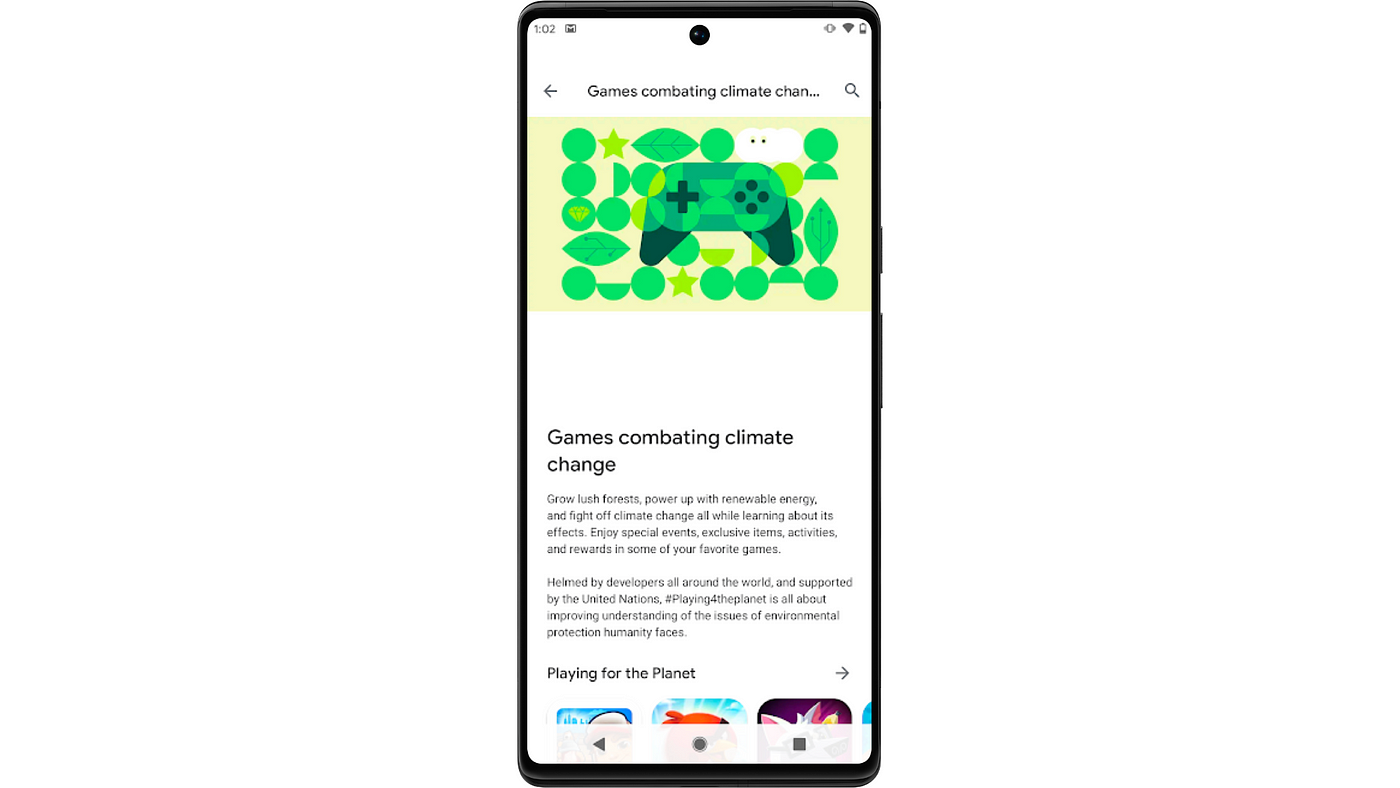Introduction
We have less than a decade to cut global emissions to have a chance of limiting global heating to 1.5°c. As a company decision-maker, this gives you a huge opportunity to make your strategic choices matter. At first glance, you may feel that turning attention to your company’s digital footprint is unnecessary. After all, digital is immaterial, right? Yet, every smartphone tap or scroll relies on an energy-consuming physical infrastructure.
This post explains why becoming a sustainability-aware app or game is a strategic imperative. It also shares actionable examples of how industry leaders and Google are helping drive decarbonization at scale through seemingly small efficiency gains.
From our partners:
A strategic imperative
As sustainability-aware apps strive to use fewer resources, they are faster, more efficient, and more performant, which can also lower costs. In fact, 26% of businesses are motivated to become sustainable to improve their operational efficiency.
As a product designer, developer, or CMO of a digital product, you may be questioning what sustainability has to do with the digital realm. Indeed, carbon emissions from digital products are much lower than is often reported. Also, the IEA states that “data centers and data transmission networks” are one of the few industry sectors on track to meet emissions targets laid out in the Paris Agreement. However, the digital sector is responsible for 4% of greenhouse gas emissions and global electricity consumption, which are predicted to climb to ~9% by 2030.
There’s a good chance your investors are required to report on Environmental, Social, and Governance (ESG) components. Leading VC firms are integrating sustainability clauses into term sheets and shareholder agreements to nudge startups towards more climate-conscious practices. In fact, startups such as Delivery Hero are committing to adopt a sustainability mindset. If adopted, the European Union’s Corporate Sustainability Reporting Directive will see large companies operating in the EU required to disclose their emissions.
Finally, business leaders are under increasing scrutiny from multiple sources: consumers, legislators, and employees. 73% of American voters say corporations should do more to address climate change, and around 80% of global consumers expect brands to be transparent about their environmental impact. Therefore, it is time to identify steps your team can take to accelerate your sustainability strategy.
Carbon-aware engineering culture and backend optimization
There are many ways to make your digital product more sustainable. A starting point is the backend. For the development and deployment of backend services, Google provides an Infrastructure-as-a-Service (IaaS) and Platform-as-a-Service (PaaS) offering known as Google Cloud Platform (GCP), which includes the well-known app backend environment Firebase.
Since 2007, Google has been carbon neutral, Also, since 2017 Google has matched 100% of its electricity consumption with renewable energy purchases. An even more exciting and ambitious goal is to operate all data centers and campuses worldwide with carbon-free energy by 2030. Until then, Google provides tools and best practices on how to optimize a workload on GCP for sustainability:
- Move your backend to a Google Cloud region where the CFE% is high. For example, the data center in Hamina, Finland, is one of the most efficient Google DCs in Europe. With the Cloud Region Picker, you can select the most suitable region for your needs. For Firebase there is a subset of regions that are available for you.
- Cleanup and eliminate all unused resources, such as old virtual machines that exist just because they contain some data. Active Assist provides automatic recommendations for these situations.
- Consider scheduling resources. For example, if you have a virtual machine for running integration tests, assign a schedule that starts and stops them to run only 10/5 instead of 24/7.
- Refactor your backend to use a modern microservices architecture. Microservices typically reduce the amount of overhead, scale more elastically (up and down) and cause fewer resources to idle.
- Use serverless resources for your microservices. Most serverless services, such as Cloud Run or Firebase Functions, only consume resources while being used and free resources immediately after a request finishes.
- Consider moving batch jobs to the greenest region in your geo, reduce the network traffic they require between regions, and schedule them to run at times coinciding with lower grid carbon intensity (such as noon on a sunny summer day).
- Have the right foundation for additional optimization strategies. Google Cloud provides the Carbon Footprint Tool that gives insights into the CO2 emissions of all workloads running in your GCP environment. Also, you can learn more about carbon free energy for Google Cloud regions and get more ideas on how to reduce the carbon footprint in the Cloud.
With these practices in mind, you can help green your backend and can become a true sustainability champion.
Isis T. Baulig, co-founder and CTO of Climatiq, a Germany-based startup providing B2B software for carbon tracking, offers three further ways to build a more efficient backend for a mobile app business:
- Choose an efficient language (such as Rust) to reduce CPU and memory use.
- Serve your backend application closer to the mobile app to reduce the amount of information required to travel across the network.
- Deploy applications to edge computing and CDN networks to further reduce data travel on the web.
Sustainability-aware front-end strategies
There isn’t a universal measure to track a mobile app’s carbon footprint, however, some key factors determine the amount of energy required to serve an app to a user. Slower apps require more energy, so optimizing assets not only improves usability but reduces your product’s carbon footprint.
To reduce your app’s energy use:
- Improve loading times by compressing and optimizing your assets, using caching, and removing redundant images and videos.
- Remove unnecessary code by shrinking, obfuscating, and optimizing to minimize the amount of data sent over the network.
- Support Dark Theme. Lighting the pixels on your user’s screen requires a lot of energy. While Dark Theme (available in Android 10 (API level 29) and higher) won’t impact older devices with LCD screens, supporting Dark Theme can help users with OLED-powered screens to reduce power use by ~40%, depending on phone brightness settings.
Embedding sustainability into your value proposition
Climate-conscious features
Some digital services are uniquely placed to embed sustainability into their core product value proposition. For example, retail and travel apps. Google recently shared its goal to help one billion people make more sustainable choices by embedding carbon emissions information into Google Flights and surfacing whether a hotel is Green Key or EarthCheck certified.
The value proposition of Germany-based Graphmasters’s NUNAV Navigation app is to optimize routes and reduce emissions using collaborative routing:

If focusing on consumers fails to inspire key sustainability-aware features, consider how your company can work with partners and suppliers to make a difference. For example, Sweden’s Karma is on a mission to eliminate food waste by making the sustainable choice the most rewarding one. The company has been using Google’s BigQuery ML on its granular sales data to provide businesses with forecasts, collecting real-time data about what’s being wasted at a granular level. With machine learning, Karma can then use that data to start predicting and ultimately preventing food waste from happening in the first place.
If your app’s use case doesn’t lend itself to embedding sustainability call-to-actions, the next section details how you might inspire action through editorial content instead.
Climate-conscious content
You don’t need an app whose main value proposition is sustainability to have a sustainability-aware product. As a member of Leaders for Climate Action, the developers of audio-learning app Blinkist have publicly committed to taking steps to reduce their carbon footprint. In addition to measuring their carbon footprint and applying sustainability principles to their office, they promote climate-conscious content to their many users globally.

Impact beyond your product
Influencing your peers
Aside from taking steps to measure and improve their overall carbon footprint, many companies are extending their impact by publishing best practices to inspire other businesses to do the same.
London-based Space Ape advocates being transparent about your company’s journey towards decarbonization. After defining their company’s carbon footprint by following the Greenhouse Gas Protocol, offsetting their carbon emissions, and looking for more efficient ways to run their cloud services, Head of Technical Operations, Nic Walker, said:
“Our final commitment last year was to share this information and help others embark upon their own journeys. Our hope is that we can help others, and they continue to help others too; then we catalyze the process towards decarbonizing gaming.”
The team did this by running workshops with peers and teamed up with Supercell to share a playbook on how to decarbonize gaming. In 2020, Space Ape were proudly part of the UN-backed Playing for the Planet Alliance, an initiative designed to empower players to learn about climate change through existing games.

Conclusion
Ultimately, embedding digital sustainability principles aligns with your business efficiency goals. From both a voluntary and mandatory perspective, it’s clear that understanding your environmental impact and reporting it is of increasing importance to all companies.
This article has highlighted examples of developers fostering an open, transparent approach to decarbonizing their products. Follow their lead and share, in the comments, what your company is committed to doing now and into the future.
Special thanks to contributors Michael Dietz and Maria Zoe Lopez-Latorre, who provided invaluable input for this article.
By Jeni Miles
Source Android
For enquiries, product placements, sponsorships, and collaborations, connect with us at [email protected]. We'd love to hear from you!
Our humans need coffee too! Your support is highly appreciated, thank you!








